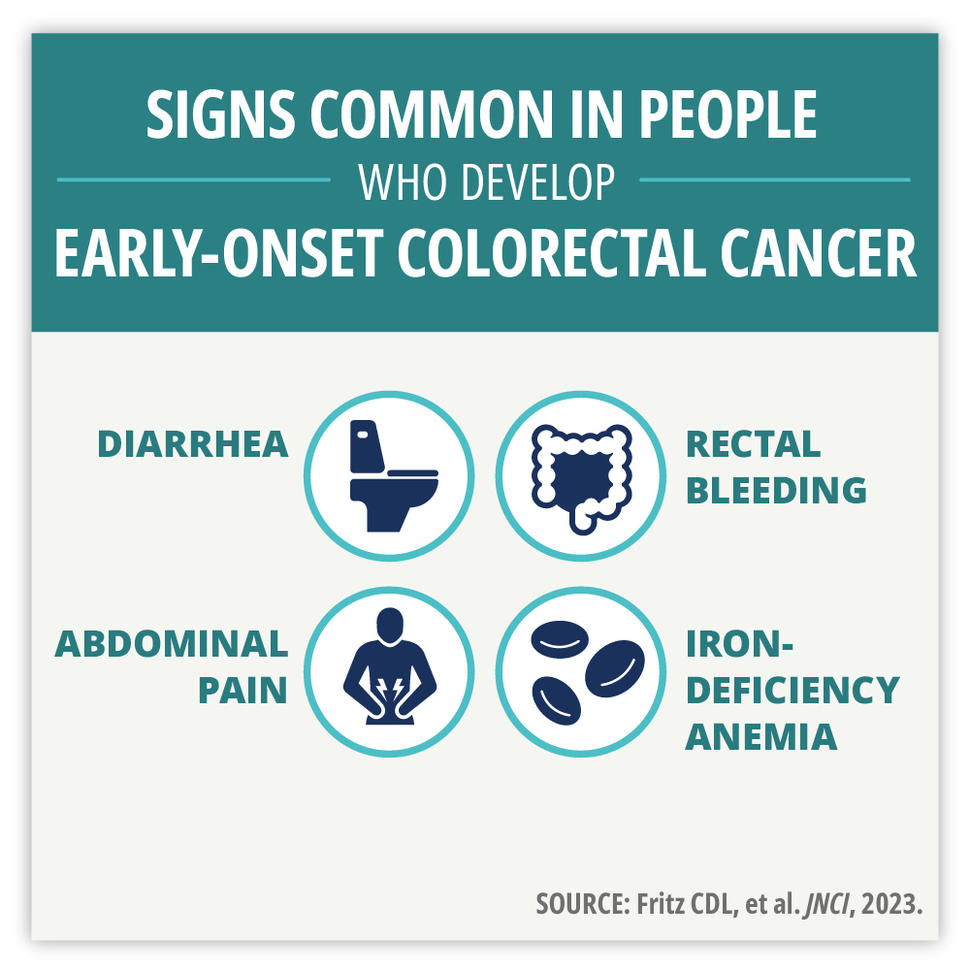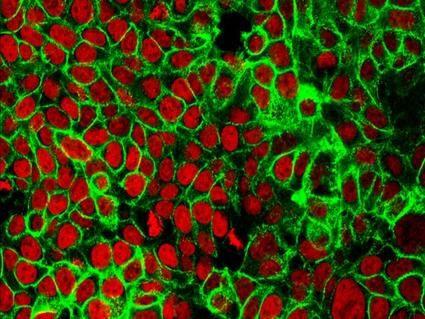Study Identifies Potential Warning Signs of Colorectal Cancer in Younger Adults
, by Linda Wang
New cases of colorectal cancer in people under the age of 50 have been rising at an alarming rate over the past several decades. But younger adults aren’t routinely screened for colorectal cancer because the disease is still relatively rare in younger adults.
Now, a study has identified four warning signs that, according to the investigators, could help encourage younger adults to seek medical care so they can potentially catch the disease at an earlier and more treatable stage.
To conduct the study, the research team analyzed insurance claims data on more than 5,000 people diagnosed before age 50, called early-onset colorectal cancer, and more than 22,000 people without cancer (controls).
The analysis showed that, in the period of 3 months to 2 years before people with colorectal cancer were diagnosed, four signs were more commonly reported in people who developed colorectal cancer than in matched controls:
- abdominal pain
- rectal bleeding
- diarrhea
- iron deficiency anemia
Having just one of these signs during this period was associated with nearly twice the likelihood of being diagnosed with early-onset colorectal cancer as having none of the signs.
Having three or more of these signs was associated with six times the likelihood of being diagnosed with the disease. The findings were published May 4 in the Journal of the National Cancer Institute.
“Colorectal cancer is no longer a disease of just the older population,” said the study’s senior investigator Yin Cao, Sc.D., of the Washington University School of Medicine in St. Louis. “For younger adults, we really want to raise awareness that, if you have any of these signs or symptoms, don’t wait to see a doctor.”
Clinicians also need to be aware of these signs, Dr. Cao continued, because it may help them identify cancers in younger people “as early as possible.”
Confronting the rise in early-onset colorectal cancer
Colorectal cancer is the third most common cancer in the United States among both men and women. The widespread adoption of screening in the mid-1980s has led to a steady decline in cases of colorectal cancer among adults aged 50 and older. However, new cases of early-onset colorectal cancer, while still relatively rare, have been rising since the mid-1990s.
In response to this trend, cancer screening guidelines now recommend people start getting screened for colorectal cancer at age 45 instead of 50. But half of early-onset colorectal cancers are diagnosed in people under 45 years old, for whom screening is not routinely recommended (except for those with inherited mutations in specific cancer-related genes, such as people with Lynch syndrome, or with a first-degree relative who has had colorectal cancer).
Younger adults are also more likely to ignore early signs of the disease, increasing the likelihood that their cancers aren’t caught until common colorectal cancer symptoms seen in older adults, such as weight loss and rectal bleeding, become severe.
Dr. Cao noted that many early-onset colorectal cancers aren’t diagnosed until the cancer is at an advanced stage. For colorectal cancer that has spread to distant organs, only 14% of people will live for 5 years or longer. If caught at localized stage, 5-year survival is 90%. In addition to improving survival, earlier diagnosis also reduces the need for aggressive treatments, which can greatly impact a younger person’s quality of life, she said.
To help improve early diagnosis in younger adults, Dr. Cao and her colleagues wondered whether they could identify certain warning signs associated with a diagnosis of early-onset colorectal cancer.
Identifying the warning signs
In the new study—funded in part by NCI—the researchers used a US insurance database that includes claims data from about 113 million adults between ages 18 and 64.
Among adults with at least 2 years of data, they identified 5,075 people ages 18–49 with colorectal cancer and 22,378 people without colorectal cancer. The two groups were matched by age and other factors, such as sex and where they live. The average age was 43.
The researchers then checked the claims data for 17 prespecified signs of colorectal cancer to see if any of these were found more frequently in the cancer group in the period between 3 months and 2 years before diagnosis than in the control group.
The four signs turned out to be more common among those who were diagnosed with early-onset colorectal cancer than those who weren’t over a similar time period.
The investigators conducted a similar analysis of older adults aged 50–64 and found that abdominal pain and rectal bleeding were only slightly more common in those with colorectal cancer. The stronger association in younger adults suggests that “there’s an avenue for early detection” among this population, Dr. Cao said.
Nearly 20% of the younger adults with early-onset colorectal cancer had one or more of these four signs between 3 months to 2 years before diagnosis. Abdominal pain was the most common sign, appearing in 11.6% of people with cancer versus 7.7% in the controls. But rectal bleeding had the strongest association with a diagnosis of early-onset colorectal cancer, followed by iron deficiency anemia. The more signs a person had, the more likely they were to have been diagnosed with the disease.
| Number of signs | Percentage of people with colorectal cancer | Increased risk of colorectal cancer | Median time to diagnosis |
| 1 | 15.6% | 2-fold | 9.7 months |
| 2 | 3.1% | 3-fold | 5.8 months |
| 3-4 | 0.6% | 6-fold | 4.8 months |
The investigators also looked at the length of delay between when warning signs appeared and when a person was diagnosed. Among those with one sign between 3 months to 2 years before diagnosis, the median delay to diagnosis was 9.7 months. Each additional sign shortened the time to diagnosis.
However, even people with 3 or more signs had a median delay of 4.8 months before diagnosis. People with rectal bleeding had a shorter delay in diagnosis than those with other signs, but the median delay was still 7 months.
Overall, though, nearly 50% of the patients with early-onset colorectal cancer experienced their first sign within 3 months of their diagnosis, with a median delay of less than a month.
Getting diagnosed as early as possible
Dr. Cao said that it’s unclear why half the patients had a much shorter delay to diagnosis than the nearly 20% diagnosed between 3 months and 2 years of diagnosis. The claims data did not provide details on the severity of the signs at the time of diagnosis.
That sort of information, she noted, could potentially offer insights into whether it was severe symptoms that drove individuals to seek medical care. The claims data also did not provide data on cancer stage at the time of diagnosis, so the researchers couldn’t tell whether any of the signs might be associated with more advanced disease at the time of diagnosis.
Nevertheless, Dr. Cao said, the findings underscore the importance of recognizing warning signs early. They may also potentially help doctors and their patients under 50 with any of these signs make decisions about whether to seek diagnostic testing, she continued, particularly if they have more than one sign, if the signs don’t go away, or if they come back.
When a younger adult notices these warning signs, “they should at least go to their primary care doctor, and, if needed, the primary doctor will refer them to a gastroenterologist,” Dr. Cao said.
In some instances, doctors may advise that younger adults showing these warning signs get an at-home stool test commonly used for colorectal cancer screening, said Gary Della'Zanna, D.O., a gastrointestinal cancer expert in NCI’s Division of Cancer Prevention, who was not involved in the study. “It’s easy, it's reasonably affordable, and it's not invasive,” Dr. Della'Zanna said.
But ultimately, he noted, more research is needed to identify younger adults who are at increased risk for early-onset colorectal cancer at the population level. Accumulating this sort of data “will help us better identify the at-risk population, because we don’t have the resources to screen everybody,” he said. “And colonoscopies are not without risk.”


